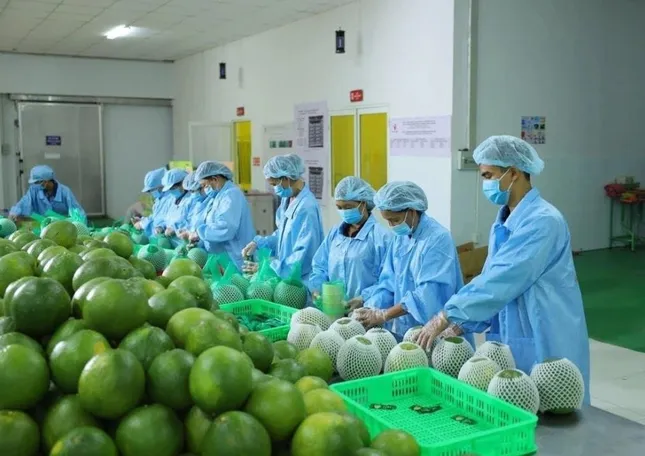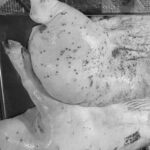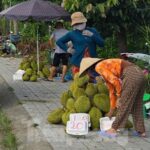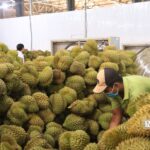Double Whammy Drags Down Fruit and Vegetable Exports
According to data from the Ministry of Agriculture and Environment, fruit and vegetable exports in May are estimated at $550 million, bringing the total exports in the first five months to $2.24 billion, a 16% decrease compared to the same period in 2024. This is an alarming decline considering the industry’s impressive growth last year.
Mr. Dang Phuc Nguyen, Secretary-General of Vinafruit, attributed the significant drop in exports since the beginning of the year to dual market impacts. The first is the impact of the Chinese market, which accounts for 46.1% of total exports, and their increasing technical measures and quality control on fruits and vegetables. The second is the impact of US tax policies.
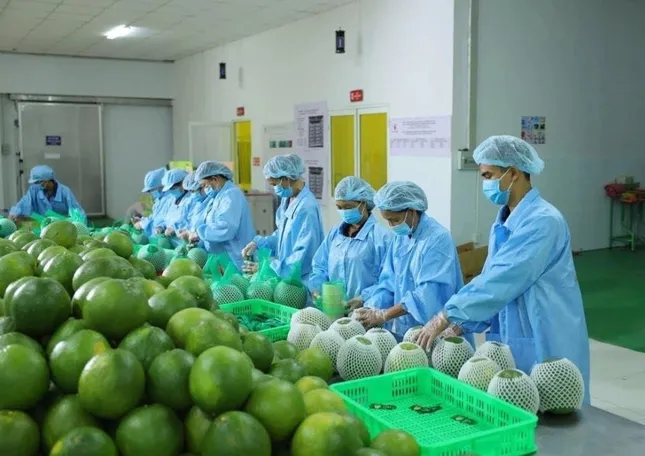
Dual market impacts hinder fruit and vegetable exports. Illustration: IT.
“The main issue is that durian exports – one of our key products – are facing challenges in the Chinese market. Additionally, the US tax policies have a ripple effect, impacting not only Vietnam but also our competitors and target markets,” said Mr. Nguyen.
Although exports to the US surged by 66% in the first four months, it still accounts for a low proportion (9.1%) of total exports. In contrast, exports to China, the largest market, decreased by 32.8%. Exports to South Korea also declined by 5.2%. Among the top 15 export markets, only Hong Kong (China) recorded a significant increase of double the previous year’s exports.
In contrast to the declining exports, fruit and vegetable imports surged. In May, import turnover reached nearly $195 million, up 10.8% over the same period last year. In the first five months, Vietnam imported nearly $987 million worth of fruits and vegetables, a sharp increase of 21.7%.
Durian Plunge Drags Down the Fruit and Vegetable Industry
Among the various fruits and vegetables, durian, known as the “king of fruits,” has attracted the most attention. After creating an export frenzy in 2023, durian exports have plummeted this year due to a series of barriers imposed by China. Specifically, durian exports in the first four months reached only $183 million, a nearly 61% decrease compared to the same period last year. In China, the main consumer market, durian exports dropped by 76%, reaching only $106 million.
The main reason for this decline is China’s tightened import regulations and their strict control over durian containing Cadmium and Yellow Dye. Many Vietnamese durian shipments have been found to contain these substances, leading to their rejection and disruption of exports.
Vietnam has been negotiating to facilitate durian clearance, and China has approved nearly 1,000 codes for growing areas and packaging facilities. However, according to Mr. Nguyen, “The quality of Vietnamese durian has not yet fully met China’s requirements, resulting in some shipments being returned. The instability in quality prevents durian exports from recovering as expected. This highlights the need for enhanced quality control in durian-growing regions.”
It’s not just durian that has taken a hit; other fruit exports have also witnessed significant declines: dragon fruit decreased by 7.3%, fresh jackfruit by 25%, and processed jackfruit by over 20%. These figures reflect the challenges faced by the industry in the early months of the year.
However, there are some bright spots. Mango exports increased by over 13%, coconut by nearly 20%, and processed coconut by a remarkable 71.3%. Banana, a stable export product, continues to maintain its market share in major markets. These products have helped the fruit and vegetable industry maintain some growth momentum amid difficulties.

Mr. Dang Phuc Nguyen, Secretary-General of Vietnam Fruit and Vegetable Association.
Mr. Nguyen assessed that the outlook for the whole year is difficult to predict. “The target of exporting $8 billion worth of fruits and vegetables is unlikely to be achieved. Even last year’s target of $7.1 billion will be challenging to attain without a significant turnaround in the last six months,” he said.
The fruit and vegetable industry is closely monitoring the international situation, especially the US tax policies and adjustments from China. “We have to wait until July to accurately assess the export prospects for 2025,” emphasized Mr. Nguyen.
Despite the challenges, there is still room for recovery for the Vietnamese fruit and vegetable industry through appropriate policy adjustments, enhanced quality control, and effective utilization of potential markets. However, the long-term challenge remains to reduce dependence on a few major markets and build a more sustainable value chain for Vietnamese agricultural products.
Unlocking New Opportunities for Vietnamese Durian in the Chinese Market
The king of fruits, durian, is set to conquer new territories as Vietnam’s durians gain traction in the massive Chinese market. With nearly 1,000 approved codes, the fragrant and flavorful Vietnamese durians are now poised to tantalize the taste buds of Chinese consumers, presenting a golden opportunity for the country’s farmers and exporters alike.
“Plunging Prices and Failed Exports: Are Durian Farmers Facing a Nightmare?”
The durian prices in the Mekong Delta have taken a significant dip as the region enters its peak harvest season. With exports to the Chinese market facing challenges, durian farmers are left hoping for better fortunes in the upcoming seasons. The profits this year are a mere fraction, a quarter to be precise, of what they were when the prices were at their peak. Despite this setback, the ‘billion-dollar fruit’ still holds allure for farmers, who remain optimistic about durian’s potential in the future.
Why Do Businesses Claiming to Be Drug-Free Still Test Positive for Saffron in Their Durian Fruits?
The discovery of high levels of cadmium in durian is primarily due to soil pollution, prolonged use of fertilizers and pesticides in cultivation. Additionally, the use of color enhancers by some businesses during the preliminary processing stage further exacerbates the issue, resulting in the presence of Sudan Yellow, a harmful dye, in the fruit.

